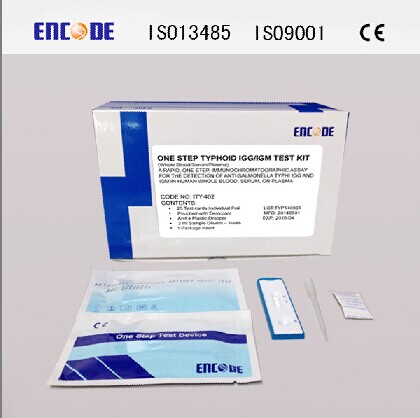INTENDED USE
The Typhoid Ab Rapid Test is a lateral flow immunoassay for the simultaneous detection and differentiation of anti-Salmonella typhi (S. typhi) IgG and IgM in human serum or plasma. It is intended to be used as a screening test and as an aid in the diagnosis of infection with S. typhi. Any reactive specimen with the Typhoid Ab Rapid Test must be confirmed with alternative testing method(s).
INTRODUCTION
Typhoid fever is caused by S. typhi, a Gram-negative bacterium. World-wide an estimated 17 million cases and 600,000 associated deaths occur annually1. Patients who are infected with HIV are at significantly increased risk of clinical infection with S. typhi2. Evidence of H. pylori infection also presents an increase risk of acquiring typhoid fever. 1-5% of patients become chronic carrier harboring S. typhi in the gallbladder.
The clinical diagnosis of typhoid fever depends on the isolation of S. typhi from blood, bone marrow or a specific anatomic lesion. In the facilities that can not afford to perform this complicated and time-consuming procedure, Filix-Widal test is used to facilitate the diagnosis. However, many limitations lead to difficulties in the interpretation of the Widal test3,4.
In contrast, the Typhoid Ab Rapid Test is a simple and rapid laboratory test. The test simultaneously detects and differentiates the IgG and the IgM antibodies to S. typhi specific antigen5 thus to aid in the determination of current or previous exposure to the S. typhi.
KIT COMPONENTS
1. Each foil pouch contains with three items inside
a. One cassette device.
b. One plastic dropper.
c. One desiccant.
2.Sample Diluent
3.One package insert (instruction for use).
PROCEDURE
Step 1: Bring the specimen and test components to room temperature if refrigerated or frozen. Mix the specimen well prior to assay once thawed.
Step 2: When ready to test, open the pouch at the notch and remove device. Place the test device on a clean, flat surface.
Step 3: Be sure to label the device with specimen’s ID number.
Step 4: Fill the pipette dropper with the specimen.
Holding the dropper vertically, dispense 1 drop (about 30-45 µL) of specimen into the sample well making sure that there are no air bubbles.
Then add 1 drop (about 35-50 µL) of Sample Diluent immediately. 
Step 5:Set up timer.
Step 6: Results can be read in 15 minutes. Positive results can be visible in as short as 1 minute.
Don’t read result after 15 minutes. To avoid confusion, discard the test device after interpreting the result.


PERFORMANCE CHARACTERISTICS
1. Clinical Performance For IgM Test
A total of 334 samples from susceptible subjects were tested by the Typhoid Ab Rapid Test and by a commercial S. typhi IgM EIA. Comparison for all subjects is showed in the following table.
|
|
Typhoid Ab Rapid Test
|
|
|
IgM EIA
|
Positive
|
Negative
|
Total
|
|
Positive
|
31
|
3
|
34
|
|
Negative
|
2
|
298
|
300
|
|
Total
|
33
|
302
|
334
|
Relative Sensitivity: 91%, Relative Specificity: 99.3%, Overall Agreement: 98.5%
2. Clinical Performance For IgG Test
A total of 314 samples from susceptible subjects were tested by the Typhoid Ab Rapid Test and by a commercial S. typhi IgG EIA kit. Comparison for all subjects is showed in the following table.
|
|
Typhoid Ab Rapid Test
|
|
|
IgG EIA
|
Positive
|
Negative
|
Total
|
|
Positive
|
13
|
1
|
14
|
|
Negative
|
2
|
298
|
300
|
|
Total
|
15
|
299
|
314
|
Relative Sensitivity: 92.9% , Relative Specificity: 99.3%, Overall Agreement: 99.0%
bio-equip.cn







